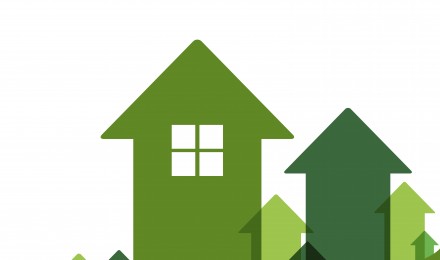The Commerce Department latest data show that new home sales declined in December, falling to an annual rate of 7.3 percent or a seasonally adjusted 369,000 units. November count was revised up from an annual rate of 377,000 to 398,000. December annual rate is 8.8 percent higher than the 339,000 annual rate compared to December 2011. Bloomberg economists predicted a sales range of 340,000 to 406,000 and median annual rate of 385,000 units.
The median sales price for new homes reached $248,000 in December. The average price climbed to $304,000.
Most New Homes Sold in Five Years
Builders sold 367,000 new homes in 2012. It’s the first annual gain in new homes sales in the last seven years. About 1.28 million units were sold in 2005. It’s also the most units sold since 2009 and the biggest year-over-year percentage increase going back to 1983. After 2005, new home sales declined each year. In 2011, new homes sales declined to an annual pace of 306,000 the lowest annual rate since 1963.
Housing market analysts anticipate a convergence of positive factors—a shortage of existing homes, historic low mortgage interest rates, a stronger job market and a higher number of households, to enable the market for new homes sales to continue its momentum in 2013.
Richard Moody, the chief economist for Birmingham-based Regions Financial Corp, caution against reading too much in the figures because “The month-to-month numbers are quite volatile.” He states that although the pace of the overall economy has been sluggish, he expects to see “steady improvement in the housing market.”
Housing Inventories and Sentiment
The supply of new homes increased from 149,000 in November to 151,000 units at the end of December. The supply of new homes for sale increased from an inventory of 4.5 months to 4.9 months. On Tuesday, the National Association of Realtors reported that the inventory of existing homes dropped to 1.82 million units, which is the lowest level in more than a decade.
The number of home sold in December, an annual rate of 4.94 million, represents the second highest monthly rate for previously-sold homes since 2009. Actual sales transactions increased 9.2 percent in 2012 compared to 4.26 million for 2011.
Builders’ expectations for the new housing market momentum continue into the current year. The builders’ sentiment index tracked by the National Association of Home Builders/Wells Fargo held steady in January, at 47. This is the highest point in six years.
However, when evaluating market conditions from a historic perspective, an index reading below 50 shows that most builders who responded to the survey still classify market conditions as poor.
In 2012, new residential home construction comprised 7.3 percent of the market. During the boom years in the past decade, this indicator made of 15 percent of residential construction activities. The survey for new home sales transactions counts signed contracts to purchase. It’s a closely watched indicator and considered a timelier gauge compared to existing home sales, which counts only closed real estate sales transactions.
The Commerce Department latest data show that new home sales declined in December, falling to an annual rate of 7.3 percent or a seasonally adjusted 369,000 units. November count was revised up from an annual rate of 377,000 to 398,000. December annual rate is 8.8 percent higher than the 339,000 annual rate compared to December 2011. Bloomberg economists predicted a sales range of 340,000 to 406,000 and median annual rate of 385,000 units.
The median sales price for new homes reached $248,000 in December. The average price climbed to $304,000.
Most New Homes Sold in Five Years
Builders sold 367,000 new homes in 2012. It’s the first annual gain in new homes sales in the last seven years. About 1.28 million units were sold in 2005. It’s also the most units sold since 2009 and the biggest year-over-year percentage increase going back to 1983. After 2005, new home sales declined each year. In 2011, new homes sales declined to an annual pace of 306,000 the lowest annual rate since 1963.
Housing market analysts anticipate a convergence of positive factors—a shortage of existing homes, historic low mortgage interest rates, a stronger job market and a higher number of households, to enable the market for new homes sales to continue its momentum in 2013.
Richard Moody, the chief economist for Birmingham-based Regions Financial Corp, caution against reading too much in the figures because “The month-to-month numbers are quite volatile.” He states that although the pace of the overall economy has been sluggish, he expects to see “steady improvement in the housing market.”
Housing Inventories and Sentiment
The supply of new homes increased from 149,000 in November to 151,000 units at the end of December. The supply of new homes for sale increased from an inventory of 4.5 months to 4.9 months. On Tuesday, the National Association of Realtors reported that the inventory of existing homes dropped to 1.82 million units, which is the lowest level in more than a decade.
The number of home sold in December, an annual rate of 4.94 million, represents the second highest monthly rate for previously-sold homes since 2009. Actual sales transactions increased 9.2 percent in 2012 compared to 4.26 million for 2011.
Builders’ expectations for the new housing market momentum continue into the current year. The builders’ sentiment index tracked by the National Association of Home Builders/Wells Fargo held steady in January, at 47. This is the highest point in six years.
However, when evaluating market conditions from a historic perspective, an index reading below 50 shows that most builders who responded to the survey still classify market conditions as poor.
In 2012, new residential home construction comprised 7.3 percent of the market. During the boom years in the past decade, this indicator made of 15 percent of residential construction activities. The survey for new home sales transactions counts signed contracts to purchase. It’s a closely watched indicator and considered a timelier gauge compared to existing home sales, which counts only closed real estate sales transactions.





